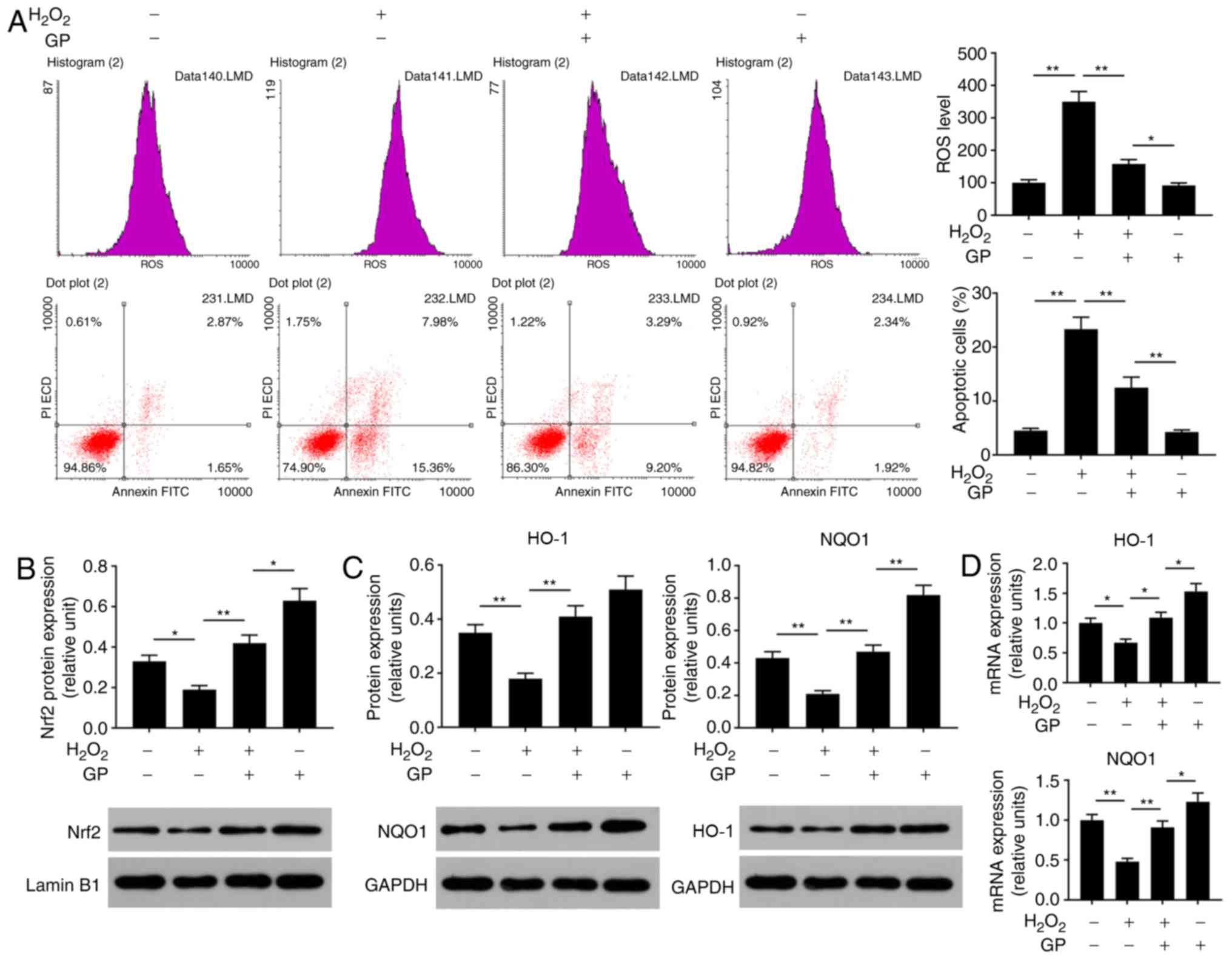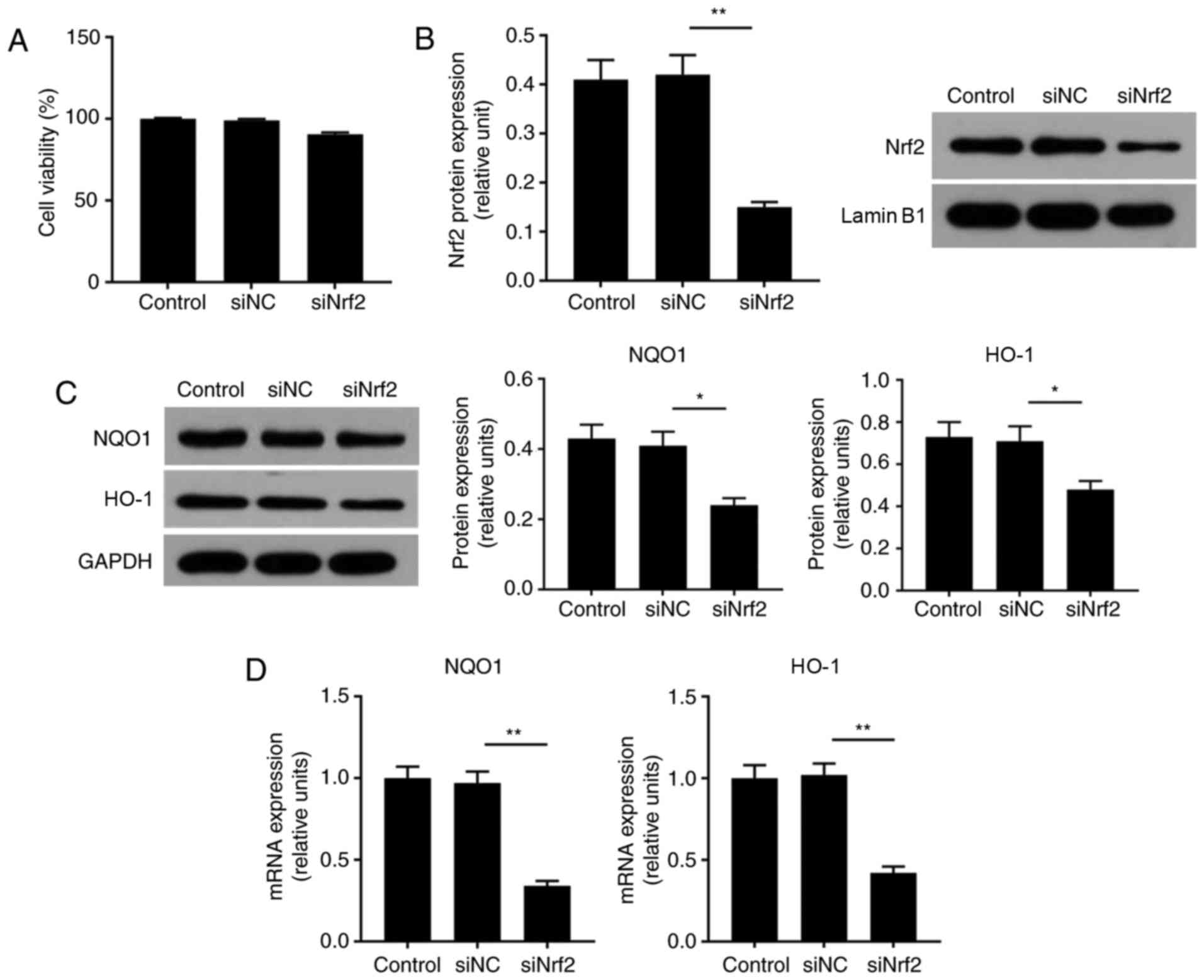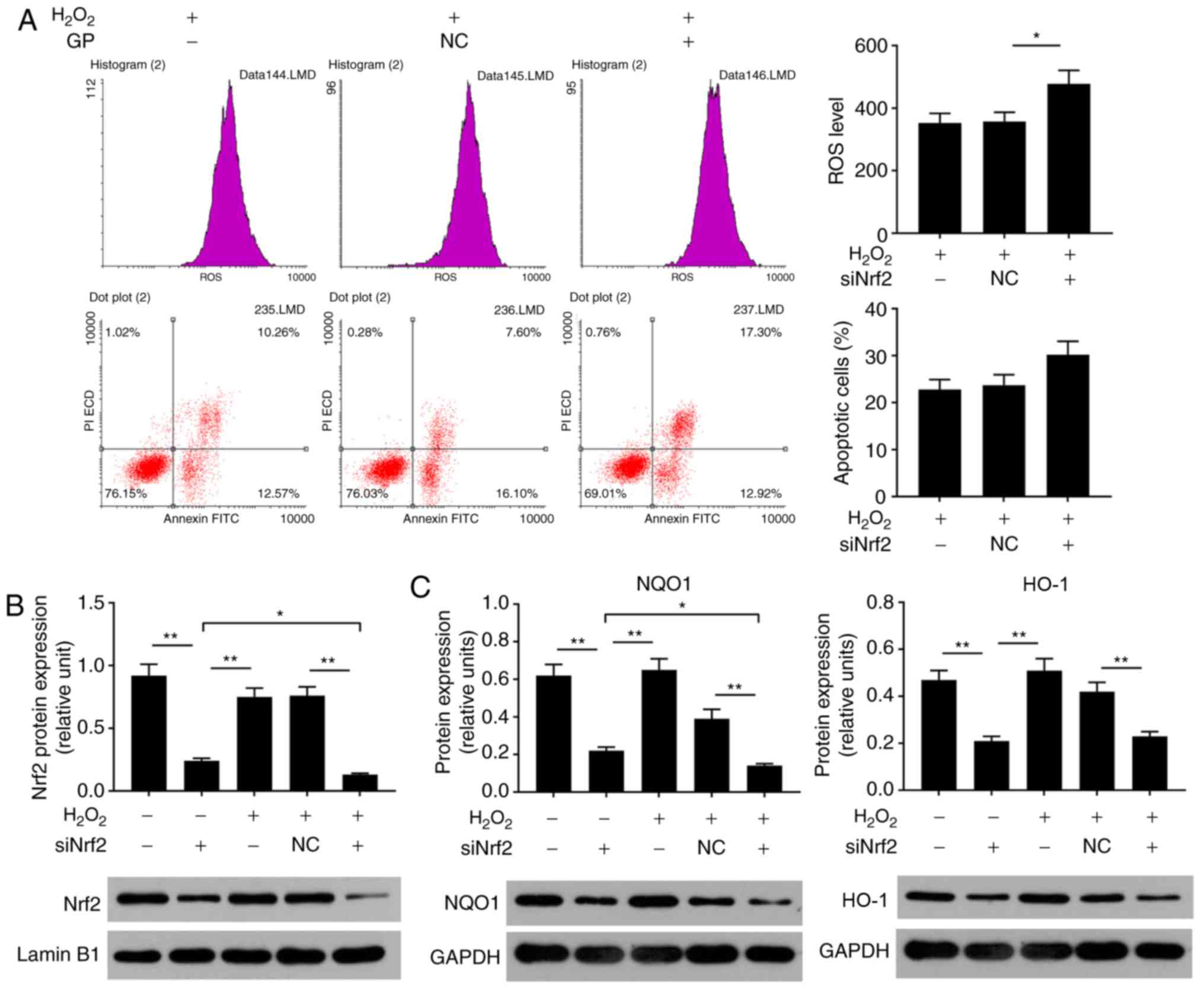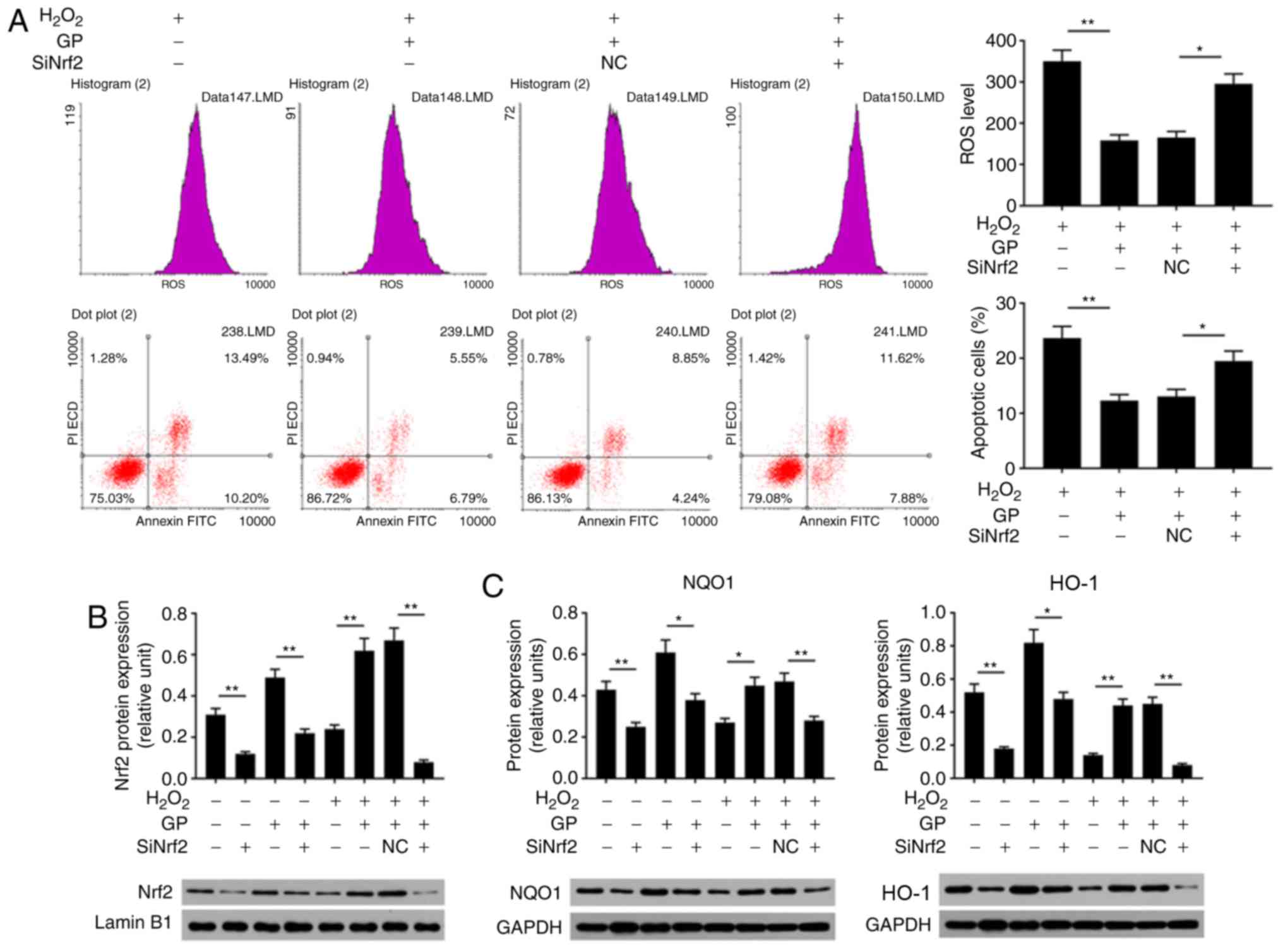|
1
|
Nowak JZ: Age-related macular degeneration
(AMD): Pathogenesis and therapy. Pharmacol Rep. 58:353–363.
2006.PubMed/NCBI
|
|
2
|
Jager RD, Mieler WF and Miller JW:
Age-related macular degeneration. N Engl J Med. 358:2606–2617.
2008. View Article : Google Scholar : PubMed/NCBI
|
|
3
|
Hernández-Zimbrón LF, Zamora-Alvarado R,
Ochoa-De la Paz L, Velez-Montoya R, Zenteno E, Gulias-Cañizo R,
Quiroz-Mercado H and Gonzalez-Salinas R: Age-related macular
degeneration: New paradigms for treatment and management of AMD.
Oxid Med Cell Longev. 2018:83746472018. View Article : Google Scholar : PubMed/NCBI
|
|
4
|
Liu L and Wu XW: Nobiletin protects human
retinal pigment epithelial cells from hydrogen peroxide-induced
oxidative damage. J Biochem Mol Toxicol. 32:e220522018. View Article : Google Scholar : PubMed/NCBI
|
|
5
|
Wang Y, Kim HJ and Sparrow JR: Quercetin
and cyanidin-3-glucoside protect against photooxidation and
photo-degradation of A2E in retinal pigment epithelial cells. Exp
Eye Res. 160:45–55. 2017. View Article : Google Scholar : PubMed/NCBI
|
|
6
|
Dun Y, Vargas J, Brot N and Finnemann SC:
Independent roles of methionine sulfoxide reductase A in
mitochondrial ATP synthesis and as antioxidant in retinal pigment
epithelial cells. Free Radic Biol Med. 65:1340–1351. 2013.
View Article : Google Scholar : PubMed/NCBI
|
|
7
|
Jiang H, Wu M, Liu Y, Song L, Li S, Wang
X, Zhang YF, Fang J and Wu S: Serine racemase deficiency attenuates
choroidal neovascularization and reduces nitric oxide and VEGF
levels by retinal pigment epithelial cells. J Neurochem.
143:375–388. 2017. View Article : Google Scholar : PubMed/NCBI
|
|
8
|
Lee CH, Kwak SC, Kim JY, Oh HM, Rho MC,
Yoon KH, Yoo WH, Lee MS and Oh J: Genipin inhibits RANKL-induced
osteoclast differentiation through proteasome-mediated degradation
of c-Fos protein and suppression of NF-κB activation. J Pharmacol
Sci. 124:344–353. 2014. View Article : Google Scholar
|
|
9
|
Kim ES, Jeong CS and Moon A: Genipin, a
constituent of Gardenia jasminoides Ellis, induces apoptosis and
inhibits invasion in MDA-MB-231 breast cancer cells. Oncol Rep.
27:567–572. 2012.
|
|
10
|
Lim W, Kim O, Jung J, Ko Y, Ha J, Oh H,
Lim H, Kwon H, Kim I, Kim J, et al: Dichloromethane fraction from
Gardenia jasminoides: DNA topoisomerase 1 inhibition and oral
cancer cell death induction. Pharm Biol. 48:1354–1360. 2010.
View Article : Google Scholar : PubMed/NCBI
|
|
11
|
Machida K, Oyama K, Ishii M, Kakuda R,
Yaoita Y and Kikuchi M: Studies of the constituents of Gardenia
species. II. Terpenoids from Gardeniae Fructus. Chem Pharm Bull
(Tokyo). 48:746–748. 2000. View Article : Google Scholar
|
|
12
|
Zuo T, Zhu M, Xu W, Wang Z and Song H:
Iridoids with genipin stem nucleus inhibit
lipopolysaccharide-induced inflammation and oxidative stress by
blocking the NF-κB pathway in polycystic ovary syndrome. Cell
Physiol Biochem. 43:1855–1865. 2017. View Article : Google Scholar
|
|
13
|
Hoshovs’ka IUV, Shymans’ka TV and Sahach
VF: Effect of UCP2 activity inhibitor genipin on heart function of
aging rats. Fiziol Zh. 55:28–34. 2009.In Ukrainian.
|
|
14
|
Ayyasamy V, Owens KM, Desouki MM, Liang P,
Bakin A, Thangaraj K, Buchsbaum DJ, LoBuglio AF and Singh KK:
Cellular model of Warburg effect identifies tumor promoting
function of UCP2 in breast cancer and its suppression by genipin.
PLoS One. 6:e247922011. View Article : Google Scholar : PubMed/NCBI
|
|
15
|
Dando I, Fiorini C, Pozza ED, Padroni C,
Costanzo C, Palmieri M and Donadelli M: UCP2 inhibition triggers
ROS-dependent nuclear translocation of GAPDH and autophagic cell
death in pancreatic adenocarcinoma cells. Biochim Biophys Acta.
1833:672–679. 2013. View Article : Google Scholar
|
|
16
|
Kensler TW, Wakabayashi N and Biswal S:
Cell survival responses to environmental stresses via the
Keap1-Nrf2-ARE pathway. Annu Rev Pharmacol Toxicol. 47:89–116.
2007. View Article : Google Scholar
|
|
17
|
Nguyen T, Nioi P and Pickett CB: The
Nrf2-antioxidant response element signaling pathway and its
activation by oxidative stress. J Biol Chem. 284:13291–13295. 2009.
View Article : Google Scholar : PubMed/NCBI
|
|
18
|
Zhang M, An C, Gao Y, Leak RK, Chen J and
Zhang F: Emerging roles of Nrf2 and phase II antioxidant enzymes in
neuroprotection. Prog Neurobiol. 100:30–47. 2013. View Article : Google Scholar :
|
|
19
|
Sachdeva MM, Cano M and Handa JT: Nrf2
signaling is impaired in the aging RPE given an oxidative insult.
Exp Eye Res. 119:111–114. 2014. View Article : Google Scholar :
|
|
20
|
Kang KA, Wang ZH, Zhang R, Piao MJ, Kim
KC, Kang SS, Kim YW, Lee J, Park D and Hyun JW: Myricetin protects
cells against oxidative stress-induced apoptosis via regulation of
PI3K/Akt and MAPK signaling pathways. Int J Mol Sci. 11:4348–4360.
2010. View Article : Google Scholar : PubMed/NCBI
|
|
21
|
Livak KJ and Schmittgen TD: Analysis of
relative gene expression data using real-time quantitative PCR and
the 2(−Delta Delta C(T)) method. Methods. 25:402–408. 2001.
View Article : Google Scholar
|
|
22
|
Patel AK and Hackam AS: Toll-like receptor
3 (TLR3) protects retinal pigmented epithelium (RPE) cells from
oxidative stress through a STAT3-dependent mechanism. Mol Immunol.
54:122–131. 2013. View Article : Google Scholar :
|
|
23
|
Sies H: Role of metabolic
H2O2 generation: Redox signaling and
oxidative stress. J Biol Chem. 289:8735–8741. 2014. View Article : Google Scholar : PubMed/NCBI
|
|
24
|
Chen XD, Su MY, Chen TT, Hong HY, Han AD
and Li WS: Oxidative stress affects retinal pigment epithelial cell
survival through epidermal growth factor receptor/AKT signaling
pathway. Int J Ophthalmol. 10:507–514. 2017.PubMed/NCBI
|
|
25
|
Du L, Chen J and Xing YQ: Eupatilin
prevents H2O2-induced oxidative stress and
apoptosis in human retinal pigment epithelial cells. Biomed
Pharmacother. 85:136–140. 2017. View Article : Google Scholar
|
|
26
|
Chen S, Sun P, Zhao X, Yi R, Qian J, Shi Y
and Wang R: Gardenia jasminoides has therapeutic effects on
L-NNA-induced hypertensio in vivo. Mol Med Rep. 15:4360–4373. 2017.
View Article : Google Scholar : PubMed/NCBI
|
|
27
|
Chen XL, Tang WX, Tang XH, Qin W and Gong
M: Downregulation of uncoupling protein-2 by genipin exacerbates
diabetes-induced kidney proximal tubular cells apoptosis. Ren Fail.
36:1298–1303. 2014. View Article : Google Scholar : PubMed/NCBI
|
|
28
|
Lin YH, Tsai SC, Lai CH, Lee CH, He ZS and
Tseng GC: Genipin-cross-linked fucose-chitosan/heparin
nanoparticles for the eradication of Helicobacter pylori.
Biomaterials. 34:4466–4479. 2013. View Article : Google Scholar : PubMed/NCBI
|
|
29
|
Shin JK and Lee SM: Genipin protects the
liver from ischemia/reperfusion injury by modulating mitochondrial
quality control. Toxicol Appl Pharmacol. 328:25–33. 2017.
View Article : Google Scholar : PubMed/NCBI
|
|
30
|
Yu D, Shi M, Bao J, Yu X, Li Y and Liu W:
Genipin ameliorates hypertension-induced renal damage via the
angiotensin II-TLR/MyD88/MAPK pathway. Fitoterapia. 112:244–253.
2016. View Article : Google Scholar : PubMed/NCBI
|
|
31
|
Dias HKI, Milward M, Grant M, Chapple ILC
and Griffiths HR: Sulforaphane decreases neutrophil hyperactivity
by reducing intracellular oxidative stress. Free Rad Biol Med.
53:S492012. View Article : Google Scholar
|
|
32
|
Schieber M and Chandel NS: ROS function in
redox signaling and oxidative stress. Curr Biol. 24:R453–R462.
2014. View Article : Google Scholar : PubMed/NCBI
|
|
33
|
Slimen IB, Najar T, Ghram A, Dabbebi H,
Ben Mrad M and Abdrabbah M: Reactive oxygen species, heat stress
and oxidative-induced mitochondrial damage. A review. Int J
Hyperthermia. 30:513–523. 2014. View Article : Google Scholar : PubMed/NCBI
|
|
34
|
Liu H, Liu W, Zhou X, Long C, Kuang X, Hu
J, Tang Y, Liu L, He J, Huang Z, et al: Protective effect of lutein
on ARPE-19 cells upon H2O2-induced G2/M
arrest. Mol Med Rep. 16:2069–2074. 2017. View Article : Google Scholar : PubMed/NCBI
|
|
35
|
Mitter SK, Song C, Qi X, Mao H, Rao H,
Akin D, Lewin A, Grant M, Dunn W Jr, Ding J, et al: Dysregulated
autophagy in the RPE is associated with increased susceptibility to
oxidative stress and AMD. Autophagy. 10:1989–2005. 2014. View Article : Google Scholar : PubMed/NCBI
|
|
36
|
Zhu C, Dong Y, Liu H, Ren H and Cui Z:
Hesperetin protects against H2O2-triggered
oxidative damage via upregulation of the Keap1-Nrf2/HO-1 signal
pathway in ARPE-19 cells. Biomed Pharmacother. 88:124–133. 2017.
View Article : Google Scholar : PubMed/NCBI
|
|
37
|
Zhu Y, Zhao KK, Tong Y, Zhou YL, Wang YX,
Zhao PQ and Wang ZY: Exogenous NAD(+) decreases oxidative stress
and protects H2O2-treated RPE cells against
necrotic death through the up-regulation of autophagy. Sci Rep.
6:263222016. View Article : Google Scholar
|
|
38
|
Areti A, Yerra VG, Naidu V and Kumar A:
Oxidative stress and nerve damage: Role in chemotherapy induced
peripheral neuropathy. Redox Biol. 2:289–295. 2014. View Article : Google Scholar : PubMed/NCBI
|
|
39
|
Radi E, Formichi P, Battisti C and
Federico A: Apoptosis and oxidative stress in neurodegenerative
diseases. J Alzheimers Dis. 42(Suppl 3): S125–S152. 2014.
View Article : Google Scholar : PubMed/NCBI
|
|
40
|
Su J, Shi HX, Wang LJ, Guo RX, Ren TK and
Wu YB: Chemical constituents of bark of Taxus chinensis var.
mairei. Zhong Yao Cai. 37:243–251. 2014.In Chinese. PubMed/NCBI
|
|
41
|
Xie X, Feng J, Kang Z, Zhang S, Zhang L,
Zhang Y, Li X and Tang Y: Taxifolin protects RPE cells against
oxidative stress-induced apoptosis. Mol Vis. 23:520–528.
2017.PubMed/NCBI
|
|
42
|
Huang Y, Li W, Su ZY and Kong AN: The
complexity of the Nrf2 pathway: Beyond the antioxidant response. J
Nutr Biochem. 26:1401–1413. 2015. View Article : Google Scholar : PubMed/NCBI
|
|
43
|
Hu Y, Duan M, Liang S, Wang Y and Feng Y:
Senkyunolide I protects rat brain against focal cerebral
ischemia-reperfusion injury by up-regulating p-Erk1/2, Nrf2/HO-1
and inhibiting caspase 3. Brain Res. 1605:39–48. 2015. View Article : Google Scholar : PubMed/NCBI
|
|
44
|
Vurusaner B, Gamba P, Gargiulo S, Testa G,
Staurenghi E, Leonarduzzi G, Poli G and Basaga H: Nrf2 antioxidant
defense is involved in survival signaling elicited by
27-hydroxycholesterol in human promonocytic cells. Free Radic Biol
Med. 91:93–104. 2016. View Article : Google Scholar
|
|
45
|
Liu X, Liu H, Zhai Y, Li Y, Zhu X and
Zhang W: Laminarin protects against hydrogen peroxide-induced
oxidative damage in MRC-5 cells possibly via regulating NRF2.
PeerJ. 5:e36422017. View Article : Google Scholar : PubMed/NCBI
|
|
46
|
Wang K, Jiang Y, Wang W, Ma J and Chen M:
Escin activates AKT-Nrf2 signaling to protect retinal pigment
epithelium cells from oxidative stress. Biochem Biophys Res Commun.
468:541–547. 2015. View Article : Google Scholar : PubMed/NCBI
|
|
47
|
Hu H, Hao L, Tang C, Zhu Y, Jiang Q and
Yao J: Activation of KGFR-Akt-mTOR-Nrf2 signaling protects human
retinal pigment epithelium cells from Ultra-violet. Biochem Biophys
Res Commun. 495:2171–2177. 2018. View Article : Google Scholar
|














